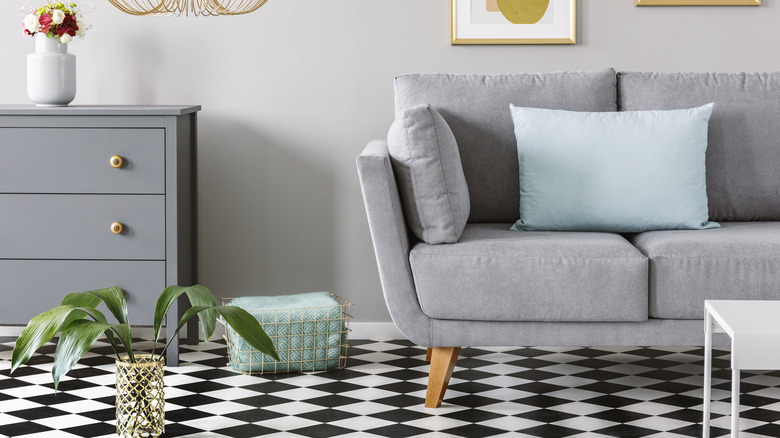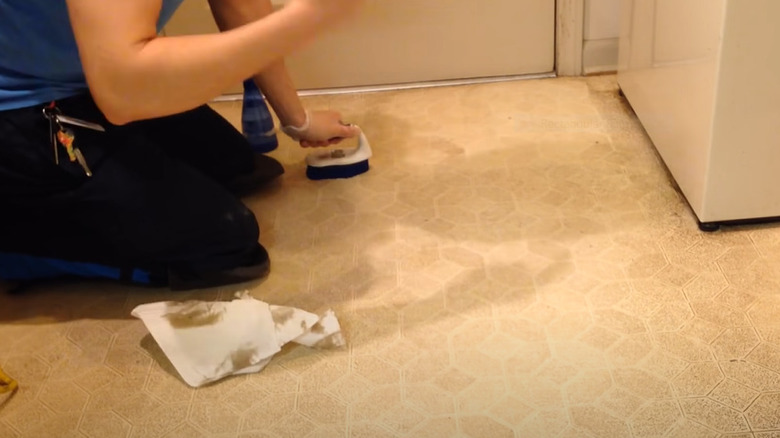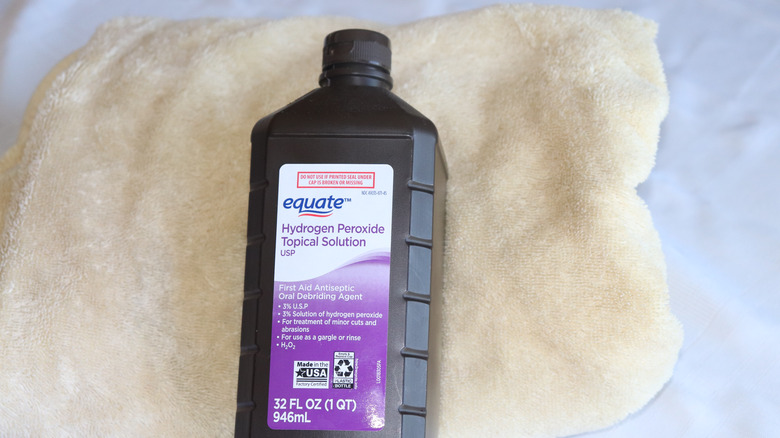A Handy Product You Have At Home Will Leave Your Linoleum Floors Looking Brand New
We may receive a commission on purchases made from links.
Made from the natural goodness of linseed oil, cork dust, pine resin, and wood fiber, linoleum flooring has been a timeless choice for homeowners, featuring diverse color options and patterns to match varying styling needs. But even this robust flooring can eventually dull under the merciless onslaught of dirt build-up, stains, and age-induced fading. So, how do you make your linoleum floor look new again? Well, all it could take is the magic of a household staple you likely have within arm's reach: hydrogen peroxide.
Far from being just a wound disinfectant, hydrogen peroxide's fizzing action is your winning bet against grime and stains. It's composed of nothing more than water and an extra oxygen molecule (H2O2, to be precise). That additional oxygen molecule is H202's firing arrow, breaking down the grime and stains marring your linoleum floor's beauty.
Hydrogen peroxide comes armed with varying potencies, ranging from a gentle 3% to a potent 90%. Before you run off to unearth your bottle, know this: the most recommended concentration for household cleaning is the humble 3%. Higher concentrations are reserved for hair bleaching, food-grade cleaning, and industrial use. Regardless of the formulation, though, do remember to exercise caution to ensure your safety while rejuvenating your linoleum flooring.
Restoring your linoleum floor with hydrogen peroxide
The glory of sparkling linoleum flooring can be yours once more with the careful application of hydrogen peroxide. Your arsenal will include a bottle of hydrogen peroxide (Swan 3% Hydrogen Peroxide Topical Solution on Amazon is an excellent choice), water, a bucket, a soft-bristled brush, a dry towel or microfiber cloth, and gloves. Kick things off by removing dust and debris on your linoleum floor.
Next in your endeavor to make your linoleum floor look new again is whipping up your magical cleaning potion. Mix equal proportions of hydrogen peroxide and water in a bucket. Suppose you pour a cup of hydrogen peroxide into the mixture; ensure you add the same volume of water. Now, slip on your protective gloves and apply the bubbling concoction to your flooring. Let the diluted hydrogen peroxide work its magic on the linoleum floors for a few minutes, which will let it chomp away at old stains and dirt.
The next step calls for a bit more elbow grease. Gently scrub away using a mop or soft-bristled brush. Remember to frequently dunk and rinse your cleaning tool in the magic mixture to maximize its effectiveness. Once satisfied with your scrubbing efforts, rinse your floor with water and dry it with your microfiber cloth to eliminate any chances of unsightly watermarks or streaks. Voilà! Watch as your linoleum floor shines bright.
Caveats for using hydrogen peroxide on linoleum flooring
Hydrogen peroxide, rather a gentle giant when it comes to cleaning, is certainly your friend when bringing your floor back to life. Yet you must use it properly. The first rule is simple: choose a hidden spot on the floor to test the 3% hydrogen peroxide solution. Additionally, mixing hydrogen peroxide and vinegar might seem like you're turning your cleaning abilities up to 11. However, the union of these two births a compound known as peracetic acid, which could cause severe irritation to your eyes, skin, nose, throat, and lungs (per The Synergist).
Floor areas with stubborn stains could benefit from undiluted hydrogen peroxide. Immerse a piece of cloth in the peroxide, then wage war on that offending stain. Leave the cloth on the stained spot and replace it only when it gets discolored by the disintegrated stains. Yet, avoid abrasive cleaning equipment that can cause more harm than good.
Post-cleaning, be sure to avoid rubber-backed rugs. These seemingly innocent fellows have a notorious habit of causing yellow stains on your linoleum. And even when itching to try an alternative cleaning solution, put those ammonia-based cleaners back in the cupboard. They are not the solutions but problems, eager to strip the shine from your polished linoleum surface. Additionally, while hydrogen peroxide is an unassumingly nonflammable compound, it could potentially start a fire if introduced to combustible organic materials. So, use caution where it's due.


